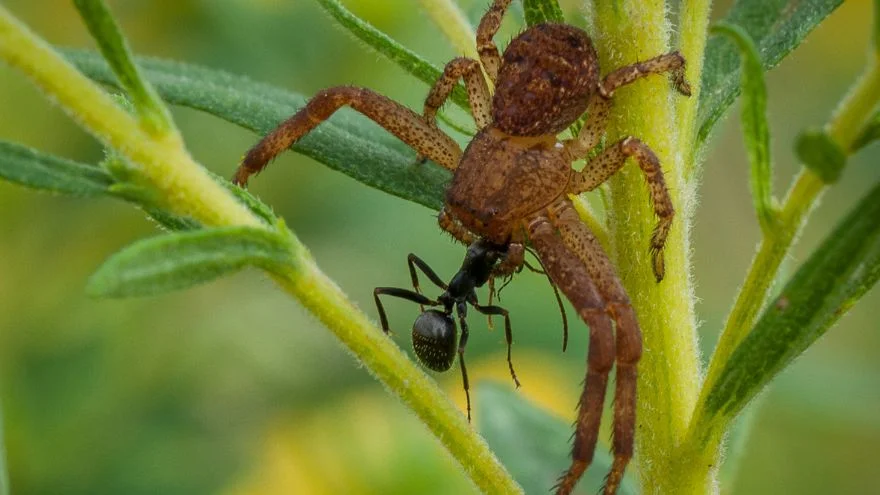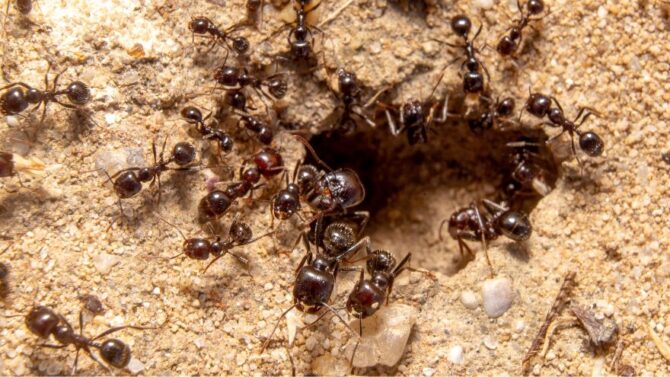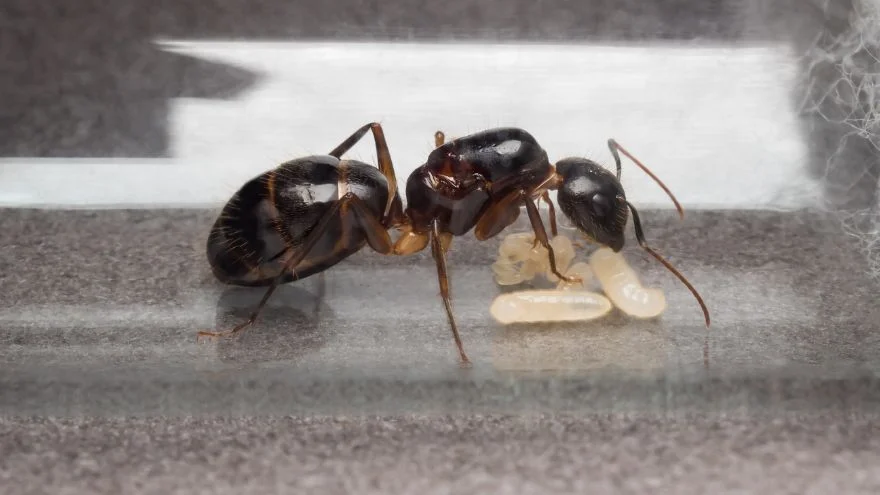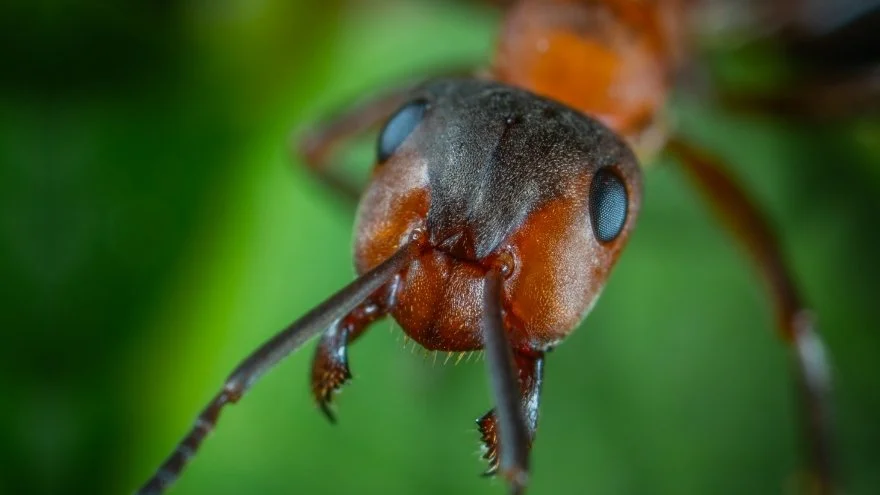Ants are one of the most common insects and have even been a subject of many wise sayings.
One can’t deny the ants working instincts, cooperative spirits, and opportunistic tendencies.
What some people may not have thought about is what animals eat ants.
Ants are prey to numerous animals, from mammals to birds and even other insects. Ants also eat a lot, and as opportunistic feeders they grab anything, making some people conclude that they may even be cannibalistic.
Continue reading to learn more about ant predators in the food chain.
What Animals Eat Ants?
Numerous animals have insects as a part of their regular diet, and ants are part of them.
- Birds such as antbirds, sparrows, robins, grouse, starlings, and antpittas
- Reptiles such as frogs, toads, lizards, and snakes.
- Mammals such as anteaters, aardvark, pangolins, bears, and coyotes
- Fish and snails
- Other insects and spiders like beetles, bugs, wolf spiders, and jumping spiders
- Parasitic fungus that eats and controls ants
Besides animals, ants are also good sources of protein for some cultures.
It might also surprise you to know that ants do eat other ants, but more on that in the course of this article.
Let’s get into the list of animals that eat ants.
Birds that Eat Ants

1. Antbirds
Antbirds live in Central and South America, where you could find around 200 of them.
Just as the name implies, antbirds have a predator-prey relationship with ants, with ants being the prey. They also eat other insects like termites.
They pose a great danger to ants as they can reach into an anthill with their beaks and pick out any unfortunate victim.
They can also catch insects on tree branches or even off the ground.
2. Antpittas
Antpittas is a bird native to both North and South America. They are small birds that bear some resemblance to the antbird.
Antpittas are experts at camouflage, which makes it hard for their prey to detect them.
Like the antbirds, antpittas can pick out ants straight from the anthill, as well as from the ground and trees.
They remain more on the ground than in the air, a characteristic that’s expected of anteaters.
3. Robins
The robin bird found in North America is more accurately described as the American robin, which is distinct from the European robin.
The American robin lives in countries like Canada, the United States, and Mexico. It feeds on fruits and invertebrates, from earthworms to ants.
While antbirds and antpittas are active in their search for ants, robins employ a more passive approach.
They lay an ambush close to the anthill in such a way that ants won’t detect them, and they rub their wings to encourage the ants to come out. Those that do are dead meat.
4. Ravens
The raven goes by names like the common raven, Western raven, or Northern raven. This bird is an omnivore, a scavenger, and as opportunistic as can be.
They prey on different forms of animals, including amphibians, reptiles, and insects. Ants aren’t their only prey, but they won’t miss the opportunity.
Ravens hunt just like robins, using the passive style of ambush and silence to find ants.
They sit close to anthills and wait for the ants to come out before picking out the ones that can be found.
5. Woodpeckers
The woodpecker is well known for its ability to “drum” on woods, from which the name is derived.
Woodpeckers can be found worldwide except in a few places like Madagascar, New Zealand, and Australia.
Many woodpecker species are omnivores, but their diet consists primarily of insects. Ants are one of the major prey.
Woodpeckers are as active as antpittas and antbirds. They stay on the offensive when going after the ants.
They set their wings close to the anthill, and when the ants climb on the wings, they pick the ants one after the other.
6. Brahminy Kites
Brahminy kites are more common in Asia and Australia, and they are classified as active ant hunters.
It was once called the red-backed sea eagle but has since been referred to only as the Brahminy kites.
While this bird is primarily a scavenger, it is also carnivorous. It eats hares, bats, and insects like ants.
Brahminy kites are group hunters, going after one bug at a time. This makes them slow hunters, but they are intentional enough to keep hunting till they get a lot of ants.
7. Flickers
Flickers is a bird genus that falls under the woodpecker family. There are 14 flicker species, all of which can be found across the Americas.
Flickers are active hunters, perhaps even more than others on this list. They don’t wait for ants to come out of the anthill, they actively go after the ants.
Unlike other woodpeckers that pick insects and other prey out of trees, flickers stay more on the ground when they hunt for ants going back to their anthill.
They also pick ants off the hill using their beak.
8. Sparrows
Sparrows are common birds, and they can be found on different continents.
They are natives of Europe, Africa, and Asia, however, and only got to the Americas via importation. They can currently be found in urban areas.
Sparrows feed mainly on fruits and seeds, but they also supplement their diet with insects.
This is where ants come in. Sparrows aren’t active hunters of ants, but if given the chance they always take it.
Mammals That Eat Ants

10. Anteater
As the name shows, the anteater is a popular ant predator. It isn’t limited to ants, however, as the anteater also eats other insects like termites.
However, anteaters form a large part of their diet. Their snout is designed to capture these insects, and because they don’t have teeth, they swallow.
Anteaters pose a great threat to ants, and an attack from one is enough to demolish an anthill. With their snout, they can swallow numerous ants.
Giant Anteaters can consume over 30,000 ants and termites in a day!
11. Aardvark
Aardvarks and anteaters are alike, and they consume the same set of bugs, from ants to termites.
It is a native of Africa, and as a nocturnal animal, it does most of its hunting at night.
Aardvark has a long, pig-nosed snout that it uses to sniff out food. Just like the anteater, aardvarks can be destructive to ants.
It uses its sharp claws to dig a hole through the anthill, its snout to sniff out the ants, and its long sticky tongue to grab as many ants as possible.
12. Pangolin
Covered in thick, hard scales, one of their most recognizable trait, Pangolins are the only mammals with scales.
The pangolin once had its image tarnished when some claims went around that this animal is responsible for COVID.
Pangolins are found in Africa and Asia. Like the aardvark and the anteater, pangolins feed more on ants and termites.
They use both their long tails and claws as tools to find ants on trees and the ground.
13. Black Bears
Black bears are omnivorous mammals that can be found only in North America.
It also goes by the name “American black bear”, and it is the smallest bear in North America.
Black bears eat ants but aren’t considered insectivores because they don’t eat ants alone. Their diet is vast.
They can consume ants, ant larvae, or even when the ant is attached to a fruit.
14. Coyotes
Coyotes are wild dogs that live in North America. It is part of the canid family and is a relative of the wolf.
Coyotes are carnivores as well as scavengers, and though their main diet is animals like rodents, deer, and birds, they are opportunistic enough to feed on berries, fruits, and insects like ants.
It might be hard to imagine a wolf-like going after ants, but that’s because the coyote isn’t a natural insectivore.
When it lacks food, however, it can go after ants for survival.
Also See: What Eats Coyotes? (10 Coyote Predators With Pictures)
14. Sloth Bears
Sloth bears are part of the bear family, but because they are as slow as sloths they’re called sloth bears.
Their noses are short and squat, unlike other mammal insectivores with long snouts. Sloth bears feed on fruits, ants, and termites.
Sloth bears use their claws to dig through the ground in search of an ant colony which they then invade, using their short snout to suck up the bugs.
The sucking sound is often very loud, and you can hear it some meters away.
Insects and Spiders that Eat Ants

15. Antlions
The Antlions is a group of over 2,000 insects, and from the larvae stage, they are known to hunt down ants.
They live longer lives as larvae, and when they become adults their times are cut short.
Antlions hunt for ants by building small pits on loose soil that ants can fall into. The unsuspecting ants fall right into the mouth of the antlion.
16. Assassin Bugs
The assassin bug does what its name states. It assassinates other insects, particularly ants. It uses venom to hunt, which shows how well deserved the name is.
Another trait that makes the assassin bug a formidable hunter is camouflage.
It hides underneath dead ants, luring other living ones to it before injecting its venom. This camouflage technique is often used by the nymph assassin bug.
17. Wolf Spiders
Wolf spiders got their names from how similar they hunt to wolves. They don’t spin webs like other spiders to trap prey.
Rather, they pursue their prey and pounce on them to eat. Like other spiders, wolf spiders are insectivorous.
Wolf spiders hunt in solitude, and they often use a passive method of ambushing the ant.
However, their mode of attack is very active, and the venom is lethal to the captured ant.
18. Phorid Flies
Phorid flies are a family of hump-backed flies known as the Phoridae.
Phorid flies are also called scuttle flies because they have a habit of scuttling off when pursued rather than flying. There are almost 4,000 species in existence today.
Phorid flies feed on ants, but their method is different from the insects we’ve seen thus far. It looks like something out of a dark sci-fi movie.
They catch the ant which then serves as a hatching ground for the female phorid fly.
When the eggs hatch, the little ones eat the ant’s brain and take over its body.
19. Jumping Spiders
Like wolf spiders, jumping spiders are big hunters of ants and do not construct webs.
Just as their name states, jumping spiders would attack their prey by pouncing on it.
They have a sharp vision—one of the sharpest a spider can have—which helps them catch prey with ease.
Jumping spiders usually hunt at night, and just like wolf spiders, they use venom to impale the prey.
20. Caterpillars
The caterpillar is the larvae stage of the Lepidoptera order, one that comprises both butterflies and moths. It has a wide range of diets and is even considered cannibalistic.
Caterpillars might seem like unlikely predator of ants, but it does eat ants alongside vegetation and leaves.
They aren’t true predators of ants, however, as they don’t actively seek these little insects.
More likely, these caterpillars eat the ants as they feast on plants.
21. Flies
Flies are some of the most common insects in the world, and they all fall under the Diptera order.
The order is a large one, containing an estimate of 1,000,000 species.
Flies feed on many things, ranging from human feces to vegetables. They also lay larvae on what they feed on.
Flies feed on ants, both as larvae and adults. The females lay their eggs on living ants which they then carry till the egg hatch into larvae.
Amphibians and Reptiles that Eat Ants

22. Poison Dart Frogs
The poison dart frog is also known as the poison frog, and the term refers to a group of frogs characterized by bright colors.
These bright colors signify toxicity, and the poison dart frog is as poisonous as the name implies.
Poison dart frogs have a variety of prey, but many species focus on insects like ants.
Poison dart frogs eat ants and other insects, which makes them poisonous.
23. Horned Lizards
The horned lizard is sometimes called the horned toad or the horny toad because it bears resemblance to a toad.
Lizards are known to feed on insects, and the horned lizard is not an exception.
They have long tongues (similar to amphibians) which they shoot inside an anthill in their invasion. These tongues have a sticky substance that glues ants.
24. Blind Snakes
The blind snake is a small, non-venomous snake that may sometimes appear to be a worm because of its size and color.
It can be found mostly in Africa and Asia, and it lives underground. It is fully named the Brahminy blind snake.
The blind snake feeds on ants and other insects they can find underground.
They use scent glands to locate the prey, and then help themselves to a nice meal.
25. Narrow-mouthed Toads
The narrow-mouthed toad includes 200 species, and it was so named because of the shape of its mouth.
This mouth does help them seek insects, which constitute their main meal.
Narrow-mouthed toads hunt using their eyes and tongue. It uses the eyes to track the ant, then its sticky tongue pulls the ant in.
Frequently Asked Questions
Do ants eat other ants?
Ants are social insects and don’t typically eat ants of their colonies. Cannibalism in some species like army ants and fire ants occurs when ant colonies are at war with each other, in a bid to capture resources.
These “resources” also involve the capture of eggs and larvae of these other ants.
Do ants eat dead ants?
Since ants are predators of their fellow ants, can ants also eat dead ants?
While we have confirmed that ants fight ants, it is unlikely that an ant will eat a dead ant. This is especially true if they are in the same colony.
They’d rather take the dead ant away from the queen so the latter won’t get contaminated. The dead ants release oleic acid which signals to live ants that the dead ant is decaying.
Summary
Ants have many predators, and each day is a game of survival for these insects.
Mammals, insects, reptiles, and amphibians can all be predators of ants, and they even prey on themselves.
However, they don’t eat any dead ant in the same colony.






